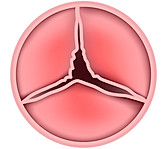Calcified Heart Valves
Our therapy
The therapy reverses calcification in the artery wall, which is similar to the type of calcification that occurs in heart valves. It could be administered as a pill, systemic intravenous injection, or local injection.
Reversing calcification would restore the functionality and flexibility of the heart

valve, thus rendering the costly replacement operation optional, or unnecessary for the moment. When detected early, calcified heart valves could be treated before an operative intervention and heart valve replacement might be necessary.
The therapy could also complement heart valve replacements, since these valves experience calcification and patients are more likely to have other calcified areas in the body. Our experience in this field is extensive. Our Principle Investigator developed and earlier de-calcified bioprosthetic heart valves. See Our Heritage.
The Condition
Calcium mineral deposits usually affect the leaflets of the valve and can prevent it from properly opening and closing. This limits the amount of blood pumped from the heart into the circulatory system. The deposits often increase as we age due to scarring and calcium buildup. Improperly functioning valve leaflets allow blood to leak back into the ventricle after it enters the aorta. This is called valvular insufficiency, or regurgitation. A valve replacement might not be necessary in early stages, but is the intervention of choice in later stages of the disease.
More than five million Americans are diagnosed with heart valve disease each year. Calcific aortic stenosis is the most common cause of aortic stenosis (AS), with an estimated 80,000-85,000 Aortic Valve Replacement procedures performed every year in the U.S. 31,000 aortic valve procedures were performed in Germany in 2015.
Current Treatment
Heart valve replacements include:
-
Mechanical valves
-
Tissue heart valves
-
Transcatheter heart valves
Transcatheter heart valve replacements are increasingly used and are projected to grow the most in the coming years because they do not require open surgery. While mechanical heart valves can last for the patient’s entire life but require lifelong anticoagulant treatment, tissue heart valves have the better hemodynamic performance and do not require anticoagulants, but have a significantly lower durability and can re-calcify just as normal valves, limiting the use of tissue valves to the elderly.
Heart valve replacement costs vary dramatically depending on the country. Highest prices are seen in the US (up to $200.000 ), while it is cheaper in European countries (Germany around €55.000, Spain €25.000). Complications occur in 35% of cases in the US, which means significant risks, and explains the increased use of trans-catheter replacements.
Technological focus is gravitating towards minimally-invasive trans-catheter heart valve replacements, with biggest growth in that segment also projected to happen in Europe and USA.
Two main players on the market are Edwards Lifesciences & Medtronic. Medtronic has products in all three segments (mechanical, tissue, and transcatheter), Edwards only has tissue valves and TAVR products. Both have developed the now-used gold standard products for TAVR. Major players for mechanical or tissue valves are beyond that St. Jude Medical (gold-standard products for mechanical valves) and Sorin Group.
There is research on creating patient-individual heart valves from the patient’s own cells in the lab, but these procedures have only been used in research and are not approved by the FDA or other regulatory bodies and are years away from entering the market.
Heart valve market 2013 was around $2 billion worldwide, expected to more than double in the next ten years. US and German market make up over 50% of the total market, with the German segment projected to grow most in the next ten years. Compound annual growth rate 11.4%.